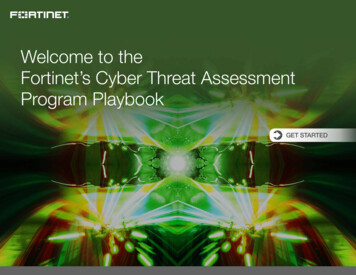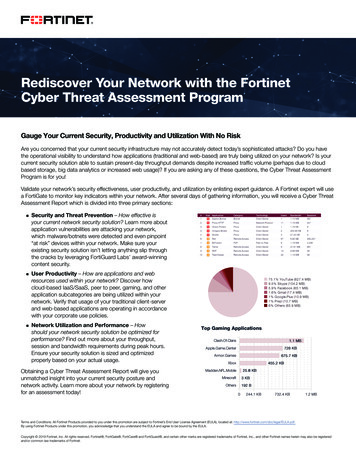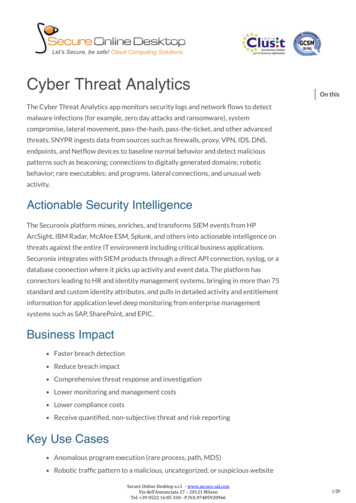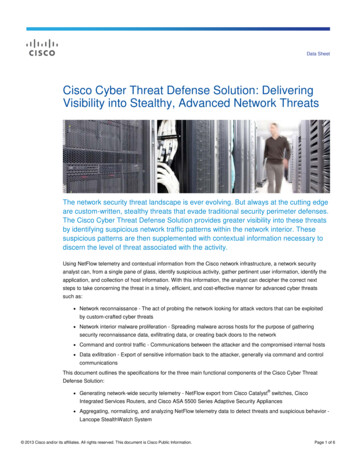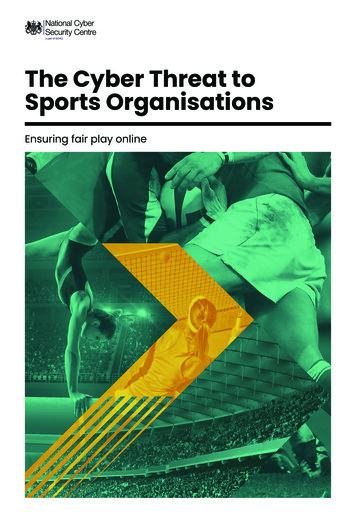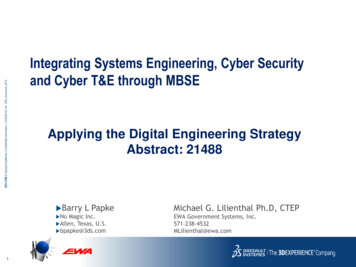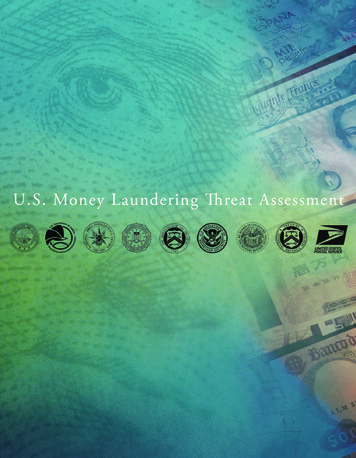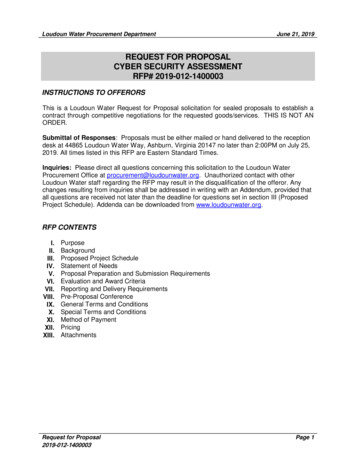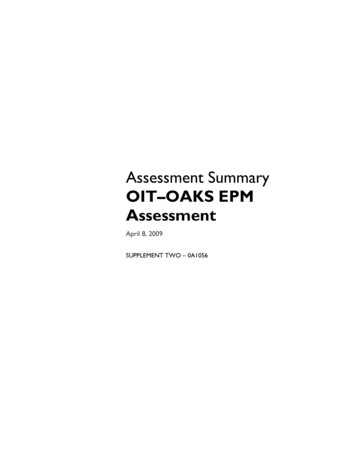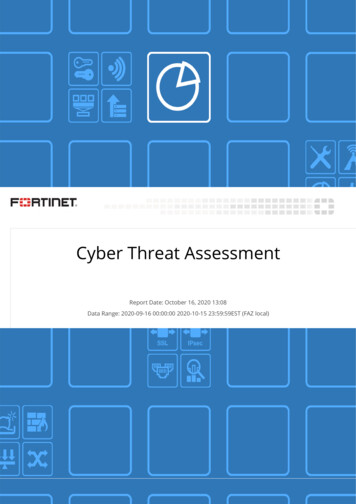
Transcription
Cyber Threat AssessmentReport Date: October 16, 2020 13:08Data Range: 2020-09-16 00:00:00 2020-10-15 23:59:59EST (FAZ local)
Table of ContentsOrganizational File Usage3Files Needing Inspection3Breakdown of File Types3Results of Executable Sandbox Analysis4Top Sandbox-identified Malicious EXEs4Top Sources of Sandbox Discovered Malware4Recommended Actions5Security and Threat Prevention6High Risk ApplicationsHigh Risk ApplicationsApplication Vulnerability ExploitsTop Application Vulnerability Exploits DetectedMalware, Botnets and Spyware/AdwareTop Malware, Botnets and Spyware/Adware DetectedAt-Risk Devices and HostsMost At-Risk Devices and HostsEncrypted Web TrafficHTTPS vs. HTTP Traffic RatioTop Source Country/RegionTop Source Country/RegionUser ProductivityApplication UsageApp CategoriesCloud Usage (SaaS)Cloud Usage (IaaS)Application Category BreakdownsRemote Access ApplicationsProxy ApplicationsTop Social Media ApplicationsTop Video/Audio Streaming ApplicationsTop Gaming ApplicationsTop Peer to Peer ApplicationsWeb UsageTop Web CategoriesTop Web ApplicationsWebsites FrequentedMost Visited Web DomainsTop Websites by Browsing TimeNetwork UtilizationBandwidthAverage Bandwidth by HourTop Bandwidth Consuming 11111112121213131315151515FortiGuard Security and Services16Appendix A17Devices (1)Cyber Threat Assessment (by admin) - FortiAnalyzer Host Name: FAZVM64-KVM17page 1 of 17
Executive SummaryIPS Attacks Detected: 195Malware/Botnets Detected: 3High-Risk Applications Used: 28Malicious Websites Detected: 104Last year, over 2,100 enterprises were breached as a result of poor internal security practices and latent vendor content security.The average cost of a corporate security breach is estimated at 3.5 million USD and is rising at 15% year over year. Intrusions,malware/botnets and malicious applications collectively comprise a massive risk to your enterprise network. These attackmechanisms can give attackers access to your most sensitive files and database information. FortiGuard Labs mitigates these risksby providing award-winning content security and is consistently rated among industry leaders by objective third parties such as NSSLabs, VB 100 and AV Comparatives.Applications Detected: 422Top Used Application: HTTPS.BROWSERTop Application Category: CollaborationWebsites Visited: 67656Top Website: contentsync.onenote.comTop Web Category: Information TechnologyUser application usage and browsing habits can not only be indicative of inefficient use of corporate resources, but can also indicatea lack of proper enforcement of corporate usage policies. Most enterprises recognize that personal use of corporate resources isacceptable. But there are many grey areas that businesses must keep a close eye on including: use of proxy avoidance/peer to peerapplications, inappropriate web browsing, phishing websites, and potentially illegal activity - all of which expose your company toundue liability and potential damages. With over 5,800 application control rules and 250 million categorized websites, FortiGuardLabs provides telemetry that FortiOS uses to keep your business running effectively.Total Bandwidth: 3748277127863Top Host by BandwidthPerformance effectiveness is an often undervalued aspect of security devices, but firewalls must keep up with the line speeds thattoday’s next generation switches operate at. A recent survey by Infonetics indicates that 77% of decision-makers at largeorganizations feel that they must upgrade their network security performance (100 Gbps aggregate throughput) in the comingyear. FortiGates leverage FortiASICs to accelerate CPU intensive functions such as packet forwarding and pattern matching. Thisoffloading typically results in a 5-10X performance increase when measured against competitive solutions.Cyber Threat Assessment (by admin) - FortiAnalyzer Host Name: FAZVM64-KVMpage 2 of 17
Sandbox AnalysisToday’s increasingly sophisticated threats can mask their maliciousness and bypass traditional antimalware security. Conventionalantimalware engines are, in the time afforded and to the certainty required, often unable to classify certain payloads as either goodor bad; in fact, their intent is unknown. Sandboxing helps solve this problem – it entices unknown files to execute in a protectedenvironment, observes its resultant behavior and classifies its risk based on that behavior. With this functionality enabled for yourassessment, we have taken a closer look at files traversing your network.Organizational File UsageTotal Files Detected ( )During the assessment period, we monitored the total number of files that were sent across your network. These files could havebeen email attachments, files uploaded to file sharing services, downloads from the Internet, etc. This number will give you an ideaof the sheer amount of file-based activity either inbound or outbound.Subset of Files Which Could be Sent for Sandbox Inspection ( )While some file types like .png files are extremely low risk in nature, others can be executed or contain macros and other active codethat could exhibit malicious behaviors. Common files types such as exe, doc, xls, and zip should be inspected for their potential todeliver threats to your network. Fortinet's sandboxing technologies can inspect more than 50 different file types even whileobfuscated within multiple layers of compression.Files Needing InspectionBreakdown of File TypesNo matching log data for this reportNo matching log data for this reportCyber Threat Assessment (by admin) - FortiAnalyzer Host Name: FAZVM64-KVMpage 3 of 17
Results of Executable Sandbox AnalysisTotal EXE Files Analyzed ( )As a highest risk file type, we started with executables which, after a standard anti-malware check on the FortiGate, were sent to thesandbox for further inspection. The number here represents the subset of executables that were sent to the sandbox for additionalscrutiny.Total Malicious EXEs Found ( )Of the Total EXE Files Analyzed, certain files may have tested positive for malicious threat payloads upon further inspection. Oftentimes this subsequent identification is due to later stage downloads or communications that are known to be malicious. This is thenumber of malicious files that were discovered during our executable analysis.Top Sandbox-identified Malicious EXEsNo matching log data for this reportTop Sources of Sandbox Discovered MalwareNo matching log data for this reportCyber Threat Assessment (by admin) - FortiAnalyzer Host Name: FAZVM64-KVMpage 4 of 17
Recommended ActionsApplication Vulnerability Attacks Detected ( 24 )Application vulnerabilities (also known as IPS attacks) act as entry points used to bypass security infrastructure and allow attackers afoothold into your organization. These vulnerabilities are often exploited due to an overlooked update or lack of patch managementprocess. Identification of any unpatched hosts is the key to protecting against application vulnerability attacks.Malware Detected ( 0 )Malware can take many forms: viruses, trojans, spyware/adware, etc. Any instances of malware detected moving laterally across thenetwork could also indicate a threat vector originating from inside the organization, albeit unwittingly. Through a combination ofsignature and behavioral analysis, malware can usually be prevented from executing and exposing your network to maliciousactivity. Augmenting your network with APT/sandboxing technology (e.g. FortiSandbox) can also prevent previously unknownmalware (zero-day threats) from propagating within your network.Botnet Infections ( 3 )Bots can be used for launching denial-of-service (DoS) attacks, distributing spam, spyware and adware, propagating malicious code,and harvesting confidential information which can lead to serious financial and legal consequences. Botnet infections need to betaken seriously and immediate action is required. Identify botnet infected computers and clean them up using antivirus software.Fortinet's FortiClient can be used to scan and remove botnets from the infected hosts.Malicious Websites Detected ( 104 )Malicious websites are sites known to host software/malware that is designed to covertly collect information, damage the hostcomputer or otherwise manipulate the target machine without the user's consent. Generally visiting a malicious website is aprecursor to infection and represents the initial stages of the kill chain. Blocking malicious sites and/or instructing employees not tovisit/install software from unknown websites is the best form of prevention here.Phishing Websites Detected ( 21 )Similar to malicious websites, phishing websites emulate the webpages of legitimate websites in an effort to collect personal orprivate (logins, passwords, etc.) information from end users. Phishing websites are often linked to within unsolicited emails sent toyour employees. A skeptical approach to emails asking for personal information and hovering over links to determine validity canprevent most phishing attacks.Proxy Applications Detected ( 18 )These applications are used (usually intentionally) to bypass in-place security measures. For instance, users may circumvent thefirewall by disguising or encrypting external communications. In many cases, this can be considered a willful act and a violation ofcorporate use policies.Remote Access Applications Detected ( 4 )Remote access applications are often used to access internal hosts remotely, thus bypassing NAT or providing a secondary accesspath (backdoor) to internal hosts. In the worst case scenario, remote access can be used to facilitate data exfiltration and corporateespionage activity. Many times, the use of remote access is unrestricted and internal corporate use changes should be put intopractice.P2P and Filesharing Applications ( 4 )These applications can be used to bypass existing content controls and lead to unauthorized data transfer and data policy violations.Policies on appropriate use of these applications need to be implemented.Cyber Threat Assessment (by admin) - FortiAnalyzer Host Name: FAZVM64-KVMpage 5 of 17
Security and Threat PreventionHigh Risk ApplicationsThe FortiGuard research team assigns a risk rating of 1 to 5 to an application based on the application behavioral characteristics. Therisk rating can help administrators to identify the high risk applications quickly and make a better decision on the application controlpolicy. Applications listed below were assigned a risk rating of 4 or higher.High Risk ApplicationsRiskApplication tegoryProxyClient-Server2340.64 MB3,245FastLemon.VPNProxyClient-Server32.19 MB2,855PsiphonProxyClient-Server14141.53 MB2,482Proxy.HTTPProxyNetwork-Protocol17467.49 ient-Server11.10 MB370Opera.VPNProxyClient-Server31.23 MB207Cloudflare.1.1.1.1.VPNProxyClient-Server62.03 MB177SurfEasy.VPNProxyClient-Server101.15 MB115Hotspot.ShieldProxyClient-Server17.99 KB22Hoxx.VPNProxyClient-Server136.70 KB4DroidVPNProxyClient-Server14.60 KB3Proxy.WebsitesProxyBrowser-Based1720.67 KB2ZenMateProxyBrowser-Based19.63 KB2Touch.VPNProxyClient-Server110.54 KB2HamachiProxyClient-Server11.35 KB1SOCKS4ProxyNetwork-Protocol1509 B1SOCKS5ProxyNetwork-Protocol1628 B1RDPRemote.AccessClient-Server48566.91 MB107,654BitTorrentP2PPeer-to-Peer1021.71 18 MB12,536erFigure 1: Highest risk applications sorted by risk and sessionsApplication Vulnerability ExploitsApplication vulnerabilities can be exploited to compromise the security of your network. The FortiGuard research team analyzesthese vulnerabilities and then develops signatures to detect them. FortiGuard currently leverages a database of more than 5,800known application threats to detect attacks that evade traditional firewall systems. For more information on applicationvulnerabilities, please refer to FortiGuard at: http://www.fortiguard.com/intrusion.Cyber Threat Assessment (by admin) - FortiAnalyzer Host Name: FAZVM64-KVMpage 6 of 17
Top Application Vulnerability Exploits DetectedSeverity Threat er.Command. OS Command CVE-2015-2051,CVE- ll.Kerbynet.Type.Parameter.Remote.Comma Code Injection CVE-2009-0545,CVE- nauthenticated.Remote.Co Code etConfig.Remote.Code.Exe Code Injection CVE-2019-16759cution117OS Command CVE-2018-10561,CVE lletin.tabbedcontainer.Template.Remote.PHP.Co Code Injection CVE-2020-7373,CVE- eter.Remote.Code.Execut Code Injection CVE-2019-9082,CVE- t.Page.Comm OS Command Form.Rendering.Component.Remote.Co OS Command ore.Session.Remote.Code.ExecutionCode Injection ctionCode Injection CVE-2012-1823,CVE- ionCode tionCode ecutionCode w.Memory.Corrupti Buffer Remote.Command.In OS passInformationDisclosureCVE-2015-0204,CVE- InjectionSQL ation.DisclosureInformationDisclosure111Figure 2: Top vulnerabilities identified, sorted by severity and countCyb
Hotspot.Shield Proxy Client-Server 1 7.99 KB 22 Hoxx.VPN Proxy Client-Server 1 36.70 KB 4 DroidVPN Proxy Client-Server 1 4.60 KB 3 Proxy.Websites Proxy Browser-Based 1 720.67 KB 2 ZenMate Proxy Browser-Based 1 9.63 KB 2 Touch.VPN Proxy Client-Server 1 10.54 KB 2 Hamachi Proxy Client-Server 1 1.35 KB 1 SOCKS4 Proxy Network-Protocol 1 509 B 1 SOCKS5 Proxy Network-Protocol 1 628 B 1
